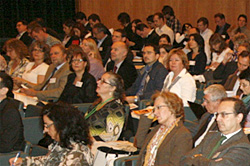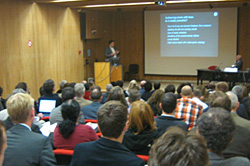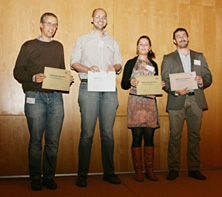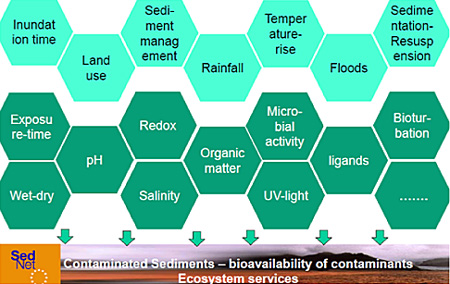Website: www.sednet.org
Compiled by: Marjan Euser (marjan.euser@deltares.nl)
Subscription Service: SedNet Secretariat (marjan.euser@deltares.nl)
Disclaimer: SedNet is not responsible for faults due to incorrectness of info in this newsletter.
Previous issues: www.sednet.org/newsletter
CONTENTS
8th International SedNet conference
Lisbon, Portugal, 6-9 November 2013
Hosted and co-organised by LNEC
“Innovative Sediment Management: How to do more with less”
Posters
The conference delegates voted for the best poster. The winning poster was
“The influence of lithology and human pressure on sediment elemental composition: the case of nine estuaries in Portugal” by Mário Mil-Homens from IPMA – the Portuguese Institute of Sea and Atmosphere.
conference. Given the tremendous diversity of Europe’s southwest coast, Lisbon proved to be a highly appropriate venue for a conference that paid special attention to estuarine and coastal sediment management. More than 170 delegates of 25 countries participated in the event.
In total 77 oral presentations were given during 13 conference sessions, and 64 posters were presented. At the closing session wrap-ups were given of all conference and special sessions.
All presentations can be downloaded from www.sednet.org.
A shared second prize was for the following four posters:
“Granular and chemical characterization of harbor sediments: Impact of particle separation and organic pollution assessment” by Fanny Coulon, Ecole des Mines d’Alès, France
| ● | “A new disposal strategy in the Scheldt-estuary: The concept and the preliminary monitoring results” by Yves Plancke from Flanders Hydraulics, Belgium |
| ● | “Chemical analyses of dredge disposal sites at the Belgian Continental Shelf” by Bavo De Witte, ILVO, Belgium |
| ● | “A minimal characterization identification approach for pre-selecting dam fine sediments reuse options” by Baptiste Anger, EDF R&D – UMR CNRS 6143 – M2C Caen, France |
| 4 of the 5 poster prize winners | |
Working Group initiatives
Thursday 7 November in the afternoon provided the opportunity for new working group initiatives – brought forward by the network – on sediment research and management. These Working Group meetings could focus on any topic in the field of sediment research and sediment management. Any conference participant who would like to brainstorm with his fellow-sediment-specialists was given the possibility to organise such a Working Group meeting. Those meetings were open for any conference participant to join and thus contribute to the discussion.
Seven ideas for Working Groups were launched, of which three effectively held a WG-meeting.
The outcome of the Working Group meetings were presented briefly in the plenary session at the end of the conference.
The most promising Working Group initiatives may get some support from SedNet to kick-off the execution of activities that they propose. A procedure how to continue with WG’s is under construction by the SedNet Steering Group and is expected to be available early 2014.
In the next articles in this newsletter summary meeting reports of the three Working Groups that organised a WG meeting is given.



Photo’s
A photo-impression of the event can be found on the website.
Acknowledgements to the conference participants that provided pictures to SedNet!
WG Sediment Science and Policy Interfacing (SSPI)
The During the SedNet conference in Lisbon a kick-off meeting was held of a new Working Group initiative on Sediment Science & Policy Interfacing. The focus of the WG will be on how to bring the sediment issue in a meaningful and understandable way to policy makers and politicians by making the connection to other policy domains. Linking sediment issues to WFD and Blueprint implementation is interesting. The message to get across here is that sustainable sediment management can/will aid the implementation of these policies. In the Blueprint ‘ecological flow’ is e.g. a key-topic. The challenge is to help policy makers realize that it is not only ‘ecological flow of water’ but also ecological flow of sediment that they should be concerned about. Policy makers should realize that besides water also sediment is needed to build and maintain habitats (floodplains, estuaries, wetlands) for biodiversity! Furthermore, also regional, local and urban (re)development is an interesting topic for sediment management that could facilitate the connection between science and policy. It would require involving other disciplines that have at the moment no or ample knowledge about sediment issues, like (landscape) architects, urban or spatial planners, regional economists, civil engineers, etc. This will be the topic for the next WG meeting: how to integrate sediment management in regional or urban (re)development? The time of the session in Lisbon was too short to discuss how we want to address this topic at the first meeting of the WG. A proposal for the next meeting will be developed in the coming months. Currently there are 25 members of the WG SSPI. The core team exists of six people; Campbell Fleming, Eugene Peck, Eric Stern, Rebecca Gardner, Jos Brils and Adriaan Slob.
The next meeting of the WG SSPI will be held mid-2014 in Venice.
Contact: Adriaan Slob – adriaan.slob@tno.nl
WG Sediments in a changing environment
Another Working Group initiative during the SedNet conference was on Sediments in a changing environment. The people attending the working group meeting expressed their interest to exchange knowledge and information on a number of topics that might change over time due to climate change, management measures or natural processes.

In order to facilitate the exchange of ideas, knowledge, information, tackling specific questions and bringing experts of different fields together, a LinkedIn discussion group has been started up. Other ideas that have been launched are the organisation of a workshop and working on a review. These ideas will be worked out in the near future.
Description of the discussion group
Suspended sediments are exposed to permanently changing conditions – during sedimentation-resuspension cycles and during their transport from rivers to the sea. Oxygen concentration, temperature, salinity, exposure to light – they will all have some impact on mobility and availability of contaminants that at some stage have been adsorbed to sediment surfaces.
The amount of suspended sediment as well as its quality may change with a changing climate. More extreme floods will resuspend more sediment and from deeper and thus more contaminated layers. In some areas, sediments may be exposed to longer periods of dry phases, when water levels in lakes and rivers are reduced during droughts.
Knowledge on the impact of these changing environmental conditions on bioavailability and toxicity of contaminants should help us linking sediment quality to ecosystem protection criteria, as well as linking river basin target values to marine target values.
Knowledge on the impact of these changing environmental conditions on hydro-morphological features and processes can encourage adaptive sediment management to minimise the risks of flooding and to optimise the functions of the ecosystem.
Contact: Eric de Deckere eric.dedeckere@portofantwerp,com and/or Susanne Heise susanne.heise@haw-hamburg.de
| LinkedIn group ‘Sediments in a changing environment’ Discussion: Polluter pays – theory and practiceAn exchange of experiences took place regarding the implementation of the polluter pays philosophy for the clean-up of contaminated sediments in the USA and Europe. Only a limited number of cases are known which were successful so far. The implementation of a cost-share model in which different stakeholders are involved to remediate contaminated sites might be more elegant to solve the clean-up of sediments polluted by multiple stakeholders. Successful and non-successful examples can still be exchanged at the discussion forum ‘Sediments in a changing environment’. |
WG Beneficial use of Dredged Material
In The third Working Group that met during the 8th International SedNet Conference in Lisbon, discussed the beneficial use of dredged material (DM).
At present it is common practice to dispose of DM at sea or in upland deposits, without any consideration of the physical, mechanical and chemical properties, and potential uses of the DM. Only limited attention has been given to make use of beneficial properties of DM itself. Engineering applications of DM, such as road construction or bricks productions, generally use small quantities of DM on a punctual time-frame while environmental applications (for example, nature development or beach nourishment) use large quantities of DM continuously on time. For instance, in Wageningen University, the project Lift up of Lowlands is running with the goal to reverse the process of land subsidence through the sustainable use of DM.
From the first meeting of the working group, it became clear that some critical issues for the beneficial use of DM are coordination between supply and demand, (absence of) flexibility of the application projects to accept materials with different properties, public acceptance, and environmental, economic and public health costs and benefits. In addition, there might be some legal restrictions and some countries consider DM a waste. Nevertheless, the EU Waste Framework Directive (2008) indicates that a waste becomes a secondary resource when the substance can be used for a specific purpose, there is a demand for the substance, the substance fulfills the requirements for such a purpose, meets the legislations and standards applicable and will not cause adverse environmental and public health impacts.
In conclusion, DM is in principle a resource and its beneficial and sustainable use should be promoted. The purpose of the Working Group on the beneficial use of DM is to identify the opportunities and to overcome the drawbacks related with the beneficial use of DM, supported with scientific research.
Contact: Bruna Oliveira, bruna.oliveira@wur.nl
Since two years, the center of materials “C2MA” and the industrial environment laboratory “LGEI” of the School of Mines of Alès in the south of France work on organic pollution remobilization and solid fine particles (< 80µm) re-sedimentation during dredging processes. The name of this project is ECODREDGE and it concerns the sediments collected in the Mediterranean Port-Camargue harbor.
The authors (Fanny COULON, Nathalie AZEMA, Catherine GONZALEZ) of the prize-winning poster: “Granular and chemical characterization of harbor sediments: Impact of particle separation and organic pollution assessment” thank the organization committee of the SedNet Conference 2013. The conference sessions provided a broad vision on dredging and sediment management, and help us to position our research developments (physico-chemical and granular characterizations, suspension stability, mater transfers) in the international sediment community.
The abstract of the poster can be found on www.sednet.org
Contact: Nathalie Azema Nathalie.Azema@mines-ales.fr
TIDE-project:
all results available on www.tide-toolbox.eu
TIDE – “Tidal River Development” was a project co-financed by the Interreg IVB North Sea Region Programme, and has been implemented between 2010 and 2013. Focusing on North Sea Region estuaries under a strong tidal influence, protected by European directives and serving as fairways to important seaports, TIDE gathered some of the leading European experts from universities, port authorities, waterways administrations and others from the Elbe (DE), Weser (DE), Scheldt (BE/NL) and Humber (UK) estuaries to find multi-beneficial solutions for future sustainable estuary development.
Due to their high dynamics and variety of uses, the management of estuaries demands an integrated approach taking into account estuarine functioning, appropriate governance and the implementation of measures based on knowledge and experience. The TIDE partnership carried out numerous interdisciplinary, inter-estuarine comparative studies on natural processes, management systems and measure implementation and developed a web-based toolbox (www.tide-toolbox.eu) containing valuable knowledge, management tools and examples of good practice.
| Sediment management was considered as a key to integrated management. Hence several TIDE reports and tools deal with the sediment strategies and related issues of the involved estuaries, for instance: | |
| ● | Morphological management of estuaries |
| ● | Management and the relation with estuarine ecosystem goods & services |
| ● | A 10-step approach for ecosystem services valuation |
| ● | Sand balance approach |
| ● | Interestuarine comparison: hydro-geomorphology |
| ● | Dredging and disposal strategies (report for each estuary) |
| ● | Evaluation of the sediment-trap near Wedel (Elbe estuary) |
| ● | Sediment relocation to shallow water near Walsoorden sandbar (Scheldt estuary) |
| ● | Secondary channels in European estuaries |
| ● | The potential alternative uses of dredged material in the Humber estuary |
| ● | Deployment of mudbugs in the Humber estuary |
| ● | Interestuarine comparison: managed realignment measures |
| ● | A measures database contains all information concerning the evaluated measures, among which several sediment management measures |
More information and all reports are available on www.tide-toolbox.eu
Contact: Dr. Kirsten Wolfstein – kirsten.wolfstein@hpa.hamburg.de
Dutch Guidance Document for Sediment Assessment available in English
The European Water Framework Directive (WFD) requires a program of measures in order to achieve a good chemical and ecological state of river basins in 2027. Every six years the water authorities present a river basin action plan that includes a set of measures. Since contaminated sediment might inhibit a good chemical or ecological state, some of these measures can be related to contamination of sediment.
The Dutch Ministry of Infrastructure and Environment has developed a Guidance Document for Sediment Assessment in 2010 that enables water managers to assess whether sediment quality inhibits compliance with the objectives of the WFD or other water quality/ecology standards such as fishery, nature, swimming water, drinking water abstraction points and recreation.
The Guidance Document has been translated in English in November 2013 and is available on Helpdesk Water.
The Guidance Document only focuses on contaminants that are predominantly bound to the sediment (log partition coefficient greater than 3). Furthermore it only focuses on the objectives that have a direct relationship with sediment quality such as the chemical standards (including nutrients) and standards for benthic and invertebrate fauna. The Guidance Document relates sediment quality to these chemical and biological standards for surface water. The relationship depends on the contamination level, but also on the properties (residence time, depth, etc.) of the water body. The Guidance expresses the contribution of the sediment in the same way as other sources are defined (e.g. mg/m2/day). The water authority can compare different measures and select the most cost-effective measures.
Innovation programmes: Eco-engineering / Building with Nature
Eco-engineering is an emerging discipline in regular projects in the Netherlands, and part of several knowledge management and innovation management activities.
Together with other stakeholders, such as citizens, companies, authorities and research institutes, Rijkswaterstaat (a department of the Dutch Ministry of Infrastructure and Environment) set up innovation programmes on this topic. Important partners in the programmes are Deltares and Ecoshape. Deltares has extensive expertise in eco-engineering and is involved in both
innovation programmes as a knowledge partner.
Ecoshape is the foundation that worked on the Building with Nature innovation programme.
The Eco-engineering and Building with Nature programmes both examine how functions of ecosystems and infrastructure can be integrated in a sustainable, climate-robust and
cost-efficient manner. To inspire others Rijkswaterstaat, Deltares and Ecoshape
published a booklet “Eco-Engineering in the Netherlands, Soft interventions with a solid impact”.
The book describes 11 examples of Eco-engineering projects in the Netherlands.
The book can be downloaded from www.deltares.nl.
18-20 March 2014: Intersol 2014 – International Conference and Exhibition on Soils, Sediments and Water, Lille, France. Theme: emerging and persistent organic pollutants (POPs) and associated risks.
www.intersol.fr
10-11 April 2014: South Baltic Conference on Dredged Materials in Dike Construction in Rostock, Germany / Hohe Düne. organised in the framework of the INTERREG project DredgDikes.
Project website: www.dredgdikes.eu
11-15 May 2014: 24th Annual Meeting of SETAC, Basel, Switzerland, with sessions on “Sorption and bioavailability of organic chemicals: mechanisms and applications in innovative remediation”, “Effects of multiple stressors and salinization on aquatic ecosystems under water scarcity”
www.basel.setac.eu
19-22 May 2014: Battelle Conference on Remediation of Chlorinated and Recalcitrant Compounds (Monterey, California)
www.battelle.org
5-6 June 2014: South Baltic Conference on New Technologies and Recent Developments in Flood Protection, Gdańsk, Poland
www.dredgdikes.eu
3-5 September 2014: River Flow 2014 – International Conference on Fluvial Hydraulics, Lausanne, Switzerland.
http://riverflow2014.epfl.ch
17-19 September 2014: 4th International Symposium on Sediment Management (I2SM), Ferrara, Italy
http://i2sm.remtechexpo.com/
17-19 September 2014: 3th International Conference on Sustainable Remediation 2014, Ferrara, Italy
www.sustrem2014.com
October 2014: ECSA 55 – Estuaries and coastal sees in a rapidly changing world, Phuket, Thailand
www.estuarinecoastalconference.com
11-14 December 2014: IAHS/ICCE 2014 international symposium – Sediment Dynamics: From the Summit to the Sea, New Orleans, USA.
www.rnr.lsu.edu
Disseminated by:
SedNet secretariat:
Mrs. Marjan Euser
Deltares
P.O. Box 85467
NL-3508 AL Utrecht
The Netherlands
E-mail marjan.euser@deltares.nl

